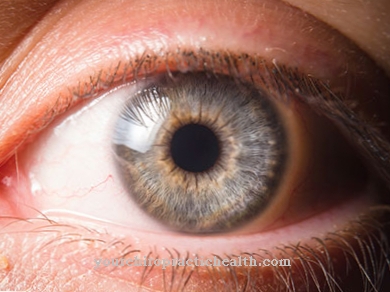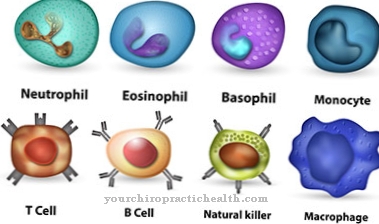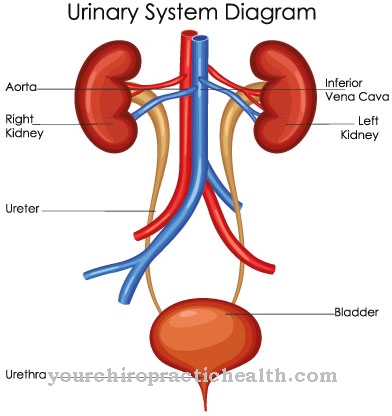The Hip joint arthrosis is a degenerative disease of the hip joint. The name Coxarthrosis is derived from the Latin term coxa for hip. Of all arthrosis, the hip is the most commonly affected.
What is hip osteoarthritis?

The Coxarthrosis goes hand in hand with a breakdown of the articular cartilage. As a result, the joint socket and the joint head are excessively stressed, and this leads to pain and restricted mobility. Hip arthrosis is divided into two types.
There is currently no known cause of primary hip arthrosis. It usually occurs from the age of 50. About 2/3 of the patients who suffer from hip osteoarthritis suffer from secondary coxarthrosis. These patients are often younger and a cause of the disease can be identified.
causes
The causes of the Hip arthrosis can be congenital malformations of the hip joint. In this case, the joint socket is often not strong enough, so that the head of the thigh does not have sufficient support, and this leads to an incorrect load on the hip joint.
If coxarthrosis occurs in families, a congenital cartilage weakness could be the cause. Other causes are inflammatory joint diseases, accidents, inappropriate strain, obesity and circulatory disorders.
Unilateral movements and a lack of exercise are also known to be the cause of coxarthrosis. The risk of developing coxarthrosis increases with age, as the cartilage tissue that protects the joint and facilitates joint movement shrinks.
Symptoms, ailments & signs
An existing hip joint arthrosis is associated with various symptoms and complaints, which should definitely be treated medically and medically. Otherwise, the existing symptoms are not expected to be eliminated. A clear sign of hip arthrosis is a significant restriction in the range of motion.
Clear pain can be heard with every movement, depending on the type of movement. Muscle tension in the affected region is also a common symptom of existing hip osteoarthritis. The joint can become stiff, especially in the morning, so that the pain is usually more intense and stronger in the morning hours. In the course of the day, the pain of movement in affected people often decreases as the muscles and joints become warm.
However, this is not an indication of an imminent improvement or healing, but a sign of a joint effusion. Another very typical symptom of hip arthrosis is severe pain when getting up from a deep armchair. During this movement, the joints that are damaged by hip osteoarthritis are directly stressed. As affected people avoid certain movements over time, considerable muscle tension can occur. Another sign of hip osteoarthritis, so treatment by a doctor is essential.
Diagnosis & course
The diagnosis for a Hip arthrosis the orthopedic surgeon provides a manual examination of hip mobility and an X-ray. A narrowing of the joint space, a deformation of the joint head and changes in the cartilage tissue can be seen on the X-ray image. Bone formations are also partially visible.
If the cartilage tissue decreases or if there are tears in the cartilage tissue, the joint surfaces of the hip joint are significantly more stressed. This causes pain when moving and walking. Typical of hip osteoarthritis in the early stages are morning pain in the groin and hip joint, which subside when the affected person moves.
As the disease progresses, there are restricted mobility, relieving postures of the affected hip and pain at rest. The patients can no longer turn the leg, later on it can no longer spread or stretch it. Due to the insufficient ability to stretch the hip joint, there is a functional shortening of the legs and a resulting deterioration in the gait pattern.
Complications
As a rule, hip arthrosis leads to severe pain. This pain can manifest itself as either pressure pain or pain at rest and has a negative impact on the patient's quality of life. The pain at rest can also occur at night and lead to sleep problems and general irritability of the patient.
In addition to pain in the hip, there is also pain in the joints and groin. The pain also restricts movement. These can lead to depression and other psychological complaints, especially in young patients. It is not uncommon for a gait disorder, such as limping or hobbling, to occur in addition to restricted mobility.
The diagnosis of hip osteoarthritis is relatively simple and clear in most cases, so that treatment can begin quickly. This takes place with the help of medication and various therapies and in most cases is not burdened with particular complications. In severe cases, an artificial hip joint is necessary for the patient. Hip arthrosis does not limit life expectancy. The treatment also cannot guarantee that the pain and discomfort will completely disappear.
When should you go to the doctor?
If hip osteoarthritis is suspected, medical advice is required. Those affected should see a doctor immediately with symptoms such as hip pain, restricted mobility and gait disorders. If the cartilage tissue continues to decrease, cracks appear in the cartilage tissue, which can cause pain and dysfunction, among other things. Medical advice is needed if the symptoms appear insidious and increase in intensity over the course of weeks or months. If the pain also occurs during quieter phases, the disease may already be well advanced and must be clarified immediately.
People who suffer from obesity, circulatory disorders or diseases of the hip joint should have the symptoms and symptoms clarified quickly. The same applies to people who move little or who cannot put excessive strain on the hip joints due to an illness. Since hip osteoarthritis is a degenerative disease, the state of health must be checked regularly. Those affected should consult their family doctor or an orthopedic surgeon and, if necessary, consult a doctor for arthritic diseases.
Doctors & therapists in your area
Treatment & Therapy
The therapy of Coxarthrosis depends on the stage of the disease and the cause. In the case of malpositions in the hip joint, corrective surgery can prevent or slow down the development of hip arthosis.
The main goals of the therapy are pain relief and a reduction in the progressive course of osteoarthritis of the hip joint. Stomach-friendly drugs are intended to eliminate or reduce the pain. The application of heat also has a soothing effect on hip problems. Physiotherapy is very important, especially with osteoarthritis of the hip. Here the patient learns exercises that maintain the mobility of the hip joint and strengthen the muscles of the hip joint.
The hip joint is better fixed and relieved by strong muscles. Furthermore, the patient learns to relieve his hip joint through certain traction exercises. Exercises in water with a decrease in severity offer very good opportunities to optimally mobilize the hip joint.
In the advanced stage of the hip joint arthosis and with significant restrictions, surgical therapy is recommended. With an artificial hip joint, the patient is able to cope with all the demands of everyday life again without symptoms. Depending on the findings, only part of the hip joint or a complete hip joint is implanted.
prevention
The emergence of the Hip arthrosis can be prevented in several ways. Sufficient and regular exercise stimulates the supply of the cartilage tissue with nutrients and helps to reduce the risk of the disease. Furthermore, care should be taken to wear comfortable shoes to avoid malpositions in the hip joint. If you are overweight, the risk of hip disease increases significantly. A reduction in body weight by ten percent reduces the risk of hip osteoarthritis by 50 percent.
You can do that yourself
In order to support the therapy of hip arthrosis, those affected can do a lot themselves. This includes a largely plant-based, wholesome and vital substance-rich diet. Overweight puts a strain on the joints and should be greatly reduced in the case of hip osteoarthritis. In addition, the fat cells continuously produce substances that promote inflammation. These cause additional joint pain. It is also advisable to avoid alcohol and sugar. Affected people should stay smoke-free. According to studies, smokers suffer significantly more from osteoarthritis pain than non-smokers.
It is also important to have existing mineral and vital substance deficiencies remedied. A family doctor or alternative practitioner can do a check on this and advise those affected. With osteoarthritis of the hip, it makes sense to take measures to detoxify and deacidify. Stress is also to be avoided. Numerous relaxation methods can help here. Adaptogens are also helpful. This is a herbal preparation that makes those affected more stress-resistant.
In order to counteract hip osteoarthritis, more exercise is recommended in everyday life. Walking, yoga or tai chi are extremely helpful. In addition, those affected should have any improper stress remedied. Shoes with high heels should be avoided entirely.



.jpg)
.jpg)








.jpg)

.jpg)
.jpg)











.jpg)